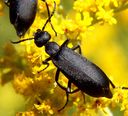Epicauta
Epicauta
Classification
- Phylum: Arthropoda
- Subphylum: Hexapoda
- Class: Insecta
- Order: Coleoptera
- Suborder: Polyphaga
- Superfamily: Tenebrionoidea
- Family: Meloidae
- Subfamily: Meloinae
- Tribe: Epicautini
- Genus: Epicauta
Pronunciation
How to pronounce Epicauta: /ˌɛpɪˈkaʊtə/
These audio files are automatically generated. While they are not always 100% accurate, they are a good starting point.
Images






Summary
Epicauta is a large genus of beetles in the blister beetle family, Meloidae, with around 360 described species. They are distributed mostly across the New World and are known for their agricultural impacts and toxic properties.
Physical Characteristics
4‒18 mm in length; similar to Lytta, but with a hairy patch on underside of profemur and antennae nearly thread-like.
Identification Tips
For species identification, palpi, tibial spurs, or hind coxae may be needed; males generally provide better identification unless a unique color pattern or shape is present. Genitalia are of little to no use in identification.
Habitat
Diverse habitats throughout the New World; particularly abundant in the southwestern United States.
Distribution
Worldwide except Australia, New Zealand, and Madagascar; mostly diverse in North and Central America, particularly in northern Arizona, and less abundant in the Arctic and northern Canada.
Diet
Adults feed on plants; larvae are predators on the eggs of grasshoppers.
Life Cycle
The life cycle details are not specified, but the larvae are predatory on grasshopper eggs.
Ecosystem Role
Primarily parasitoids of grasshopper eggs; some species feed on the eggs of other Epicauta species.
Economic Impact
Many Epicauta species are known as agricultural pests that can damage crops and cause failures.
Health Concerns
Cantharidin produced by Epicauta is toxic and can be harmful, particularly to animals like horses if ingested.
Evolution
The genus Epicauta was first described in 1834 and is one of the largest in the blister beetle family.
Similar Taxa
Tags
- beetles
- Meloidae
- Epicauta
- agricultural pests
- toxic